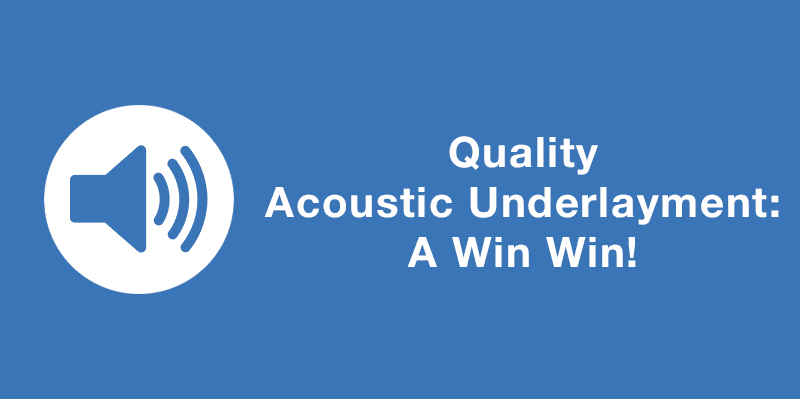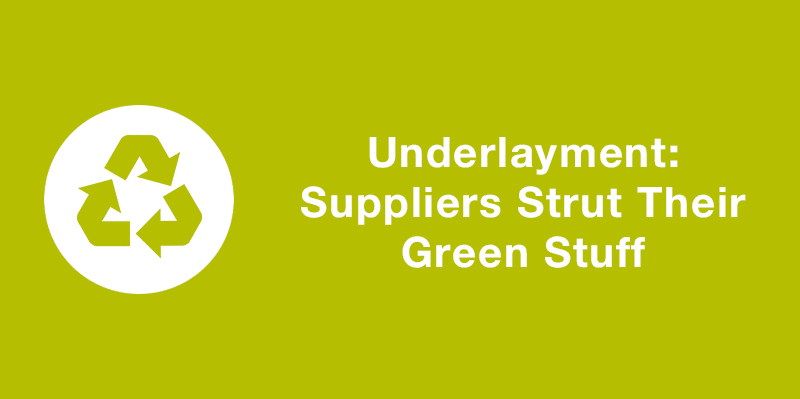Upselling underlayment for new hard surface flooring is a win-win opportunity every salesperson should take advantage of as often as possible.
As the economy rebounds and more customers make decisions based on criteria beyond bare budget, you likely will have more opportunity to create interest in value-added underlayment, a product many of your customers may not even know about, but should.
Actually, upselling underlayment is pretty easy and rewarding because the material, once explained, more or less sells itself. In private homes, high-end and mid-range condos, and multi-family residences, acoustic underlayment can have significant positive impact on a new floor installation.
A premium underlayment can enhance the new floor in terms of “wearability;” sound reduction from impact and between floors; insulating value that can affect the perceived warmth or coldness of the floor underfoot; moisture dissipation, and greater comfort when walking. It can also reduce fatigue from added support underfoot-all potential built-in benefits that can create a win-win for both end-users and sales staff.
There are premium customers in just about every market who will listen while you explain the benefits they would reap by selecting upgraded underlayment to match their new solid or engineered wood, laminate, LVT or tile floor rather than just agreeing to an off-the-shelf generic selection based only on price.
Indeed, underlayment is one of the few categories in a flooring store that, as a component of the overall installation, can be easily upgraded and improve your sale. For a relatively small amount of money compared to the cost of the finished floor, the customer gets a great deal of advantages which will endure over the life of the installation.
For example, a quality acoustic fiber underlayment that features good, uniform density and more support than entry level foam improves the performance of the new floor long-term in terms of wearability, and reduces fatigue underfoot (an attractive buying point for older homeowners).
Other attributes that a particular upgrade option may offer include the ability to better dissipate spilled liquids that seep under the finished floor to the lowest place in the room, which is the underlayment. A fiber underlayment that features a “gutter” around the perimeter will wick the moisture into the underlayment and out to the sides, from where it will eventually evaporate.
Extra Talking Points
Other talking points can be specific to the type of floor in which the customer is interested. For example, on the one hand, underlayment selected for use under laminate flooring should be both firm enough to support the overlaying floor and flexible enough to smooth out little subfloor imperfections, helping eliminate any rocking of laminate panels. And it can also help make the floor sound more like real wood.
On the other hand, underlayment designed for use under tile should have sufficient elasticity to prevent lateral cracks in a concrete subfloor from telegraphing through to the tile or grout above.
Then there is the growing fount of eco-minded customers. Green building products have become a major focus for many buyers. Increasingly, hardwood flooring and tile manufacturers are promoting their products as natural and sustainable. For customers shopping for environmentally friendly flooring, introducing eco-friendly underlayment options made from recycled materials can spur interest in an upsell.
Along the same lines, families with young children are, increasingly, concerned with indoor air quality. For those customers, bringing into the mix a third-party certified VOC-free underlayment can, likewise, lead to an upsell.
How the fibers in a particular underlayment are processed and how they lay in the padding can also affect performance. In underlayment manufactured using an air-laid process, fibers of various lengths and distributed in different directions in layers create a product that has high tensile strength, high compression and an enhanced ability to absorb moisture when compared to underlayment manufactured using conventional needle punching, which leaves pockets that may hold too much moisture for it all to dissipate. Also, all those needle holes may compromise insulating and sound reduction capabilities.
All in all, there are plenty of features to talk about when upselling underlayment. Learn your underlayments and share the knowledge. Listen to your customers’ interests and concerns and focus on premium options that best fulfill their wish list.
Original Article: Floor Trends – October 7, 2013
Join Our Newsletter
You are about to install your new flooring. As you lay the first plank you realize that


